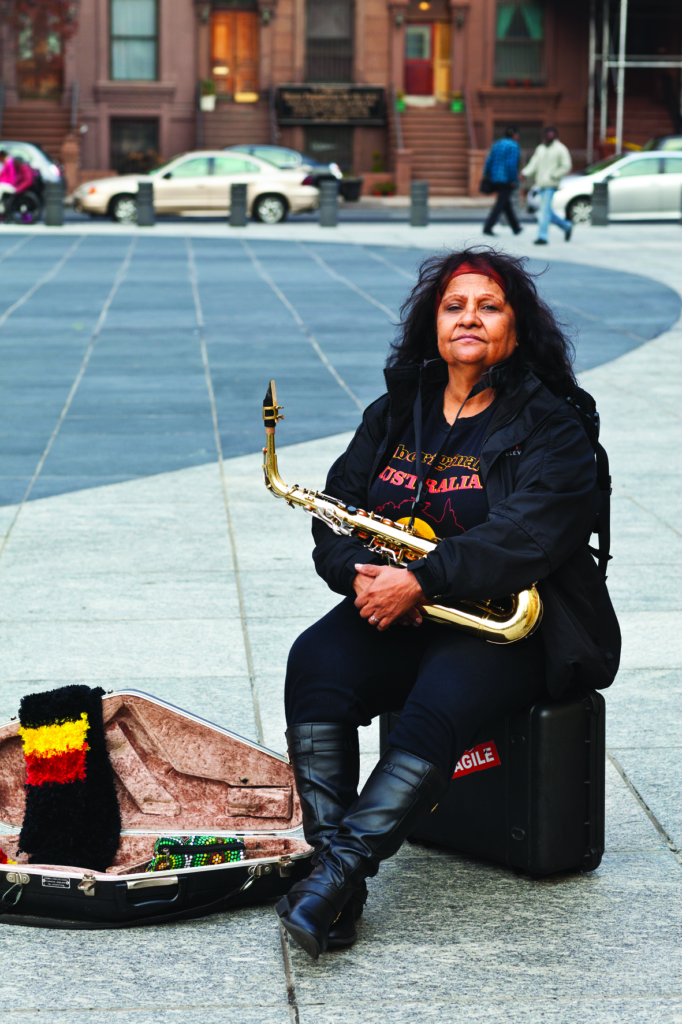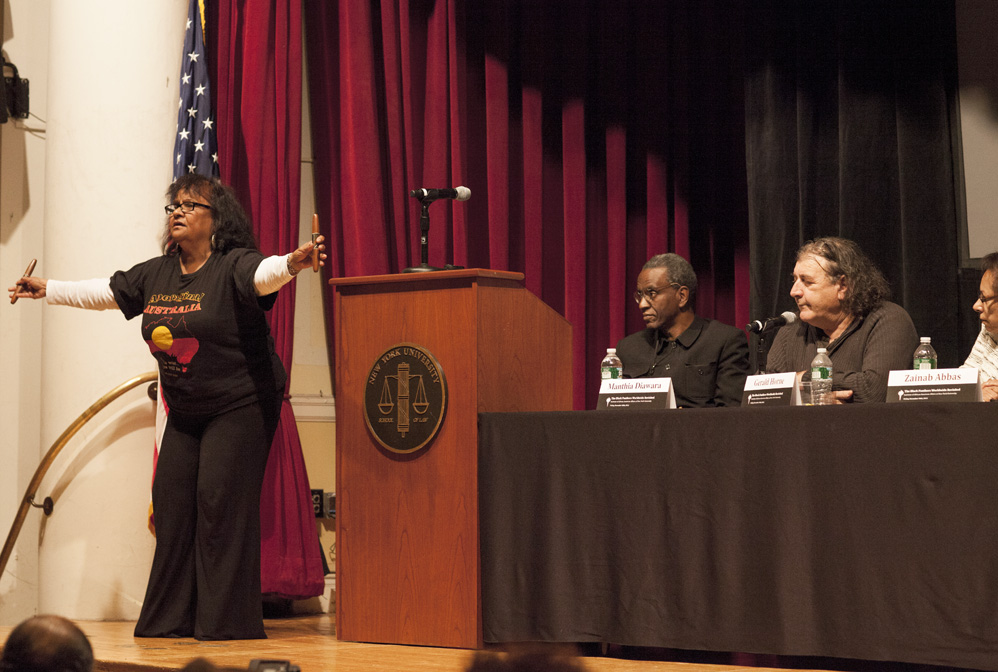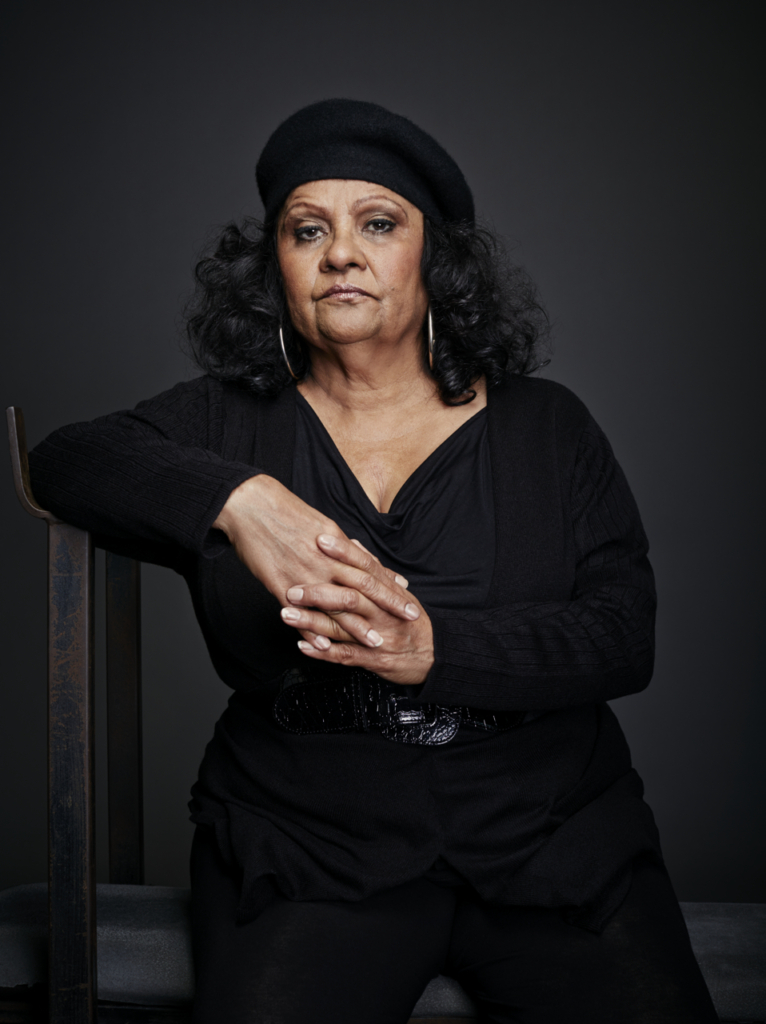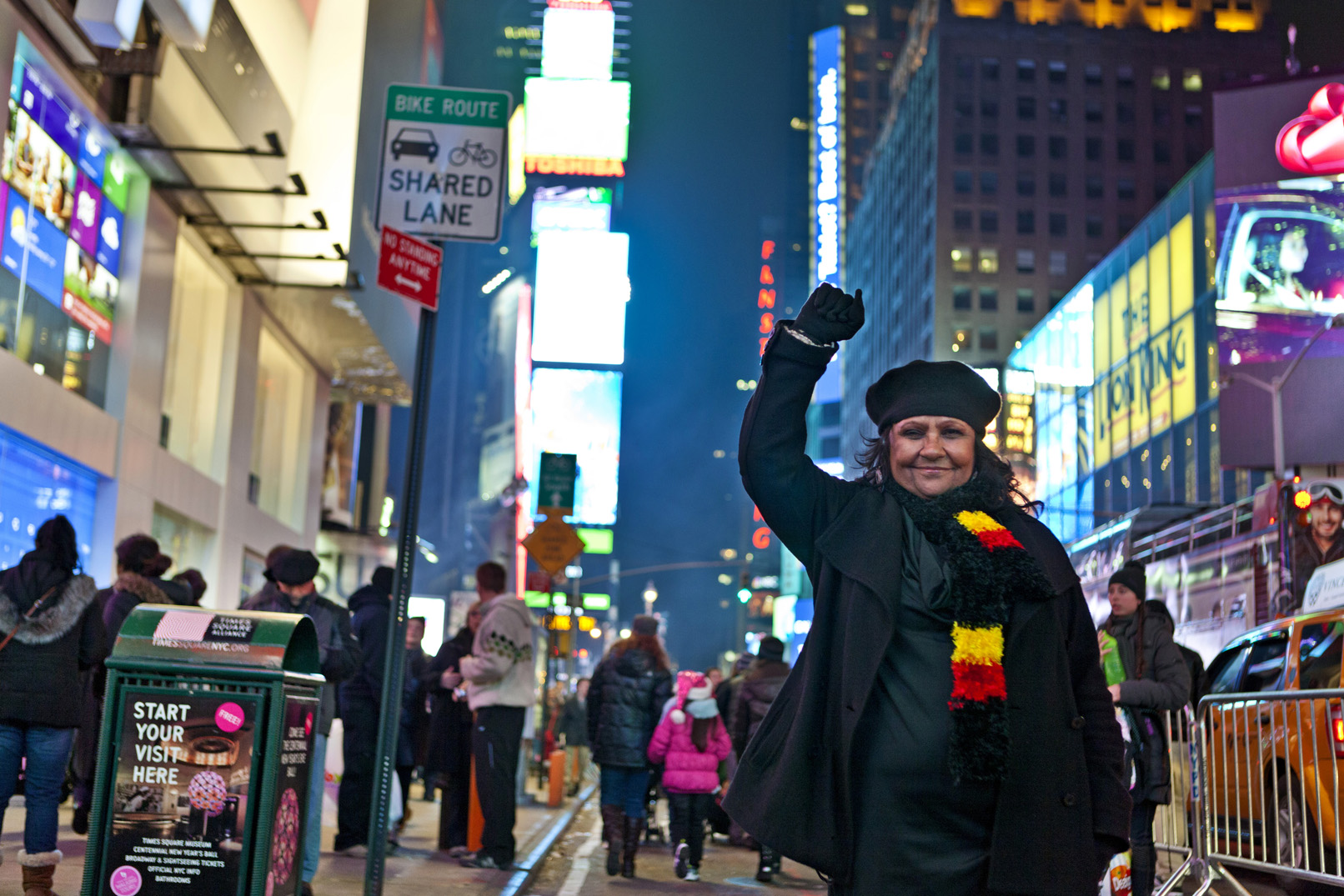Black Panther Woman (Rachel Perkins, 2014), which premiered at the Sydney Film Festival and aired on SBS this January, opens with Marlene Cummins pottering in the kitchen of her housing-commission flat in Sydney. These images are intercut with archival footage of Black Panther protests in Queensland in the early 1970s. Immediately, we are presented with a stark juxtaposition – a domestic, stereotypically female scene, and a public, tumultuous fight for rights.
‘Us women were on the front line, too. Some of us, we paid a price,’ she says.
Cummins was a member of the little-known Black Panther movement in Queensland, which lasted for less than a year after being founded in December 1971.[1]See Alyssa L Trometter, ‘“The Fire in the Belly”: Aboriginal Black Power and the Rise of the Australian Black Panther Party, 1967–1972’, PhD thesis, University of Melbourne, Victoria, 2013. Her voiceover introduces what can be taken as the manifesto of the documentary: ‘I’ve been told, “Marlene, it’s best to be quiet” […] I think it’s time black women of this country come out with the truth of the abuses.’ Is a rights movement more important than the individuals who constitute it? What about when those individuals are being abused? In Black Panther Woman, director Rachel Perkins attempts to address these questions in light of Cummins’ story.
Inspired by the American Black Panthers, the Brisbane-based Australian chapter of the movement began under the leadership of the charismatic Denis Walker. Cummins fell in love with Walker, and so began her involvement with the black rights movement. While, internationally, the movement had a great deal of momentum, the Australian Black Panthers comprised only ten members. There were skirmishes with police and the Australian Security Intelligence Organisation (ASIO) kept watch, as Walker vocally supported the broader movement’s belief in violent struggle. Other members of the Australian Black Panthers and the wider Aboriginal rights movement are interviewed, including Sam Watson, Lionel Fogarty and Lynelda Tippo, providing additional background regarding the events at the time.
There is a shift in tempo as Cummins says, ‘Black Power was a long way from 1950s Queensland, where I grew up.’ Born in Cunnamulla, Cummins was introduced to grassroots politics early on. She found her outlet in music and the arts, joining a theatre group in which she played an Aboriginal superhero rescuing women. They performed for students and the Aboriginal community, and Cummins clearly carried some of this background through to the Panthers. The film contains some wonderful archival footage of the group aping around in the woods, performing for the camera. Cummins is also a blues musician who busks regularly, playing her saxophone outside Redfern Station; in Black Panther Woman, she speaks of how her love of music began at a young age: ‘I was born an artist, a musician.’ We then see her in the present day, being welcomed on stage at a festival, before she sings: ‘Got those pension-day blues again, my man only loves me pension day […] Sweet-talking Koori man knows how to talk my cheque away.’ The images of her on stage performing to a crowd and the idea of her busking outside a train station embody two different worlds. But we soon begin to understand how these worlds coexist when Cummins explains that she has been beset by a string of addictions – alcohol, drug and nicotine – throughout her life.

It is here that we start to unearth the core of Black Panther Woman’s story. Cummins talks about putting on the facade of a strong woman. Perkins is heard off-camera: ‘You’re amazing.’ Cummins responds, ‘It’s not quite like that […] I’ve got secrets I’ve been hiding for thirty years.’ Cummins refers obliquely to ‘things that have happened’ that have led to her various addictions, the most recent and debilitating of which being her gambling addiction – ‘the hardest one’, which she still needs to kick. We can imagine Perkins deftly fashioning the documentary the way she might have shaped the interview: shepherding Cummins to touch briefly on some difficult issues, then veering away again into safer territory, enabling a later return when Cummins is more comfortable.
The safer territory, for now, is Cummins’ present-day connection with the black rights movement. Professor Kathleen Cleaver, a former American Black Panther, has asked Cummins to speak at a conference of international Panthers held in New York. Cummins’ joy at being invited to the gathering is a delight to see; she has never met Cleaver or the other original Panthers but feels ‘[they] are connected’. At the New York conference, Cummins meets representatives from a range of countries including India, Israel, New Zealand and the United Kingdom. Images of the conference are intercut with stills of Martin Luther King Jr, whom we hear in voiceover exhorting nonviolence. With regard to King’s beliefs, Cleaver comments that a nonviolent structure did not appeal to the Panthers at the time, although they did not directly denounce it. Paraphrasing Stokely Carmichael, a Trinidadian-American civil rights activist, she states that, in order for nonviolence to work, it depends on the white man having a conscience. Cummins, however, steers away from this issue, noting how violence was often the focus of any coverage of the Panthers while their social programs – which included a legal service, and a breakfast service for children that was run by the female Panthers – generally received little attention.
Cummins then attends a dinner for women Panthers during the conference, and the film begins to segue back to the more fraught area of the story. ‘Denis had a dark side,’ she explains. She says she knew that he had glassed a woman in the face with a beer bottle, and comments opaquely that she saw a side of him she did not like, which ‘was enough to drive [her] away’. She still, however, credits him with her political awareness. Cummins asserts that black women made a sacrifice: seeing black men already demonised by the media, they knew that, if they ‘pointed the finger’ at one black man, all would be tarred with the same brush. So the women remained silent.

But Walker is not the primary source of Cummins’ angst and discomfort. Although the Australian Black Panthers fell apart in under a year due to police pressure, she continued fighting for black rights and felt that change started to happen by the 1980s. However, for some women, oppression of a different kind was still very real. Cummins shares that some of the men – leaders within the community – were abusive. She falters, unsure whether she wants to delve into this. Perkins, off-camera, wants to know why Cummins feels compelled to reveal this information. Cummins responds that she is not at all sure that she does.
Gradually, Cummins is emboldened and the story emerges. She explains that a couple of Aboriginal and Torres Strait Islander leaders invited her to a party, which she later found out didn’t exist. Instead, it was a set-up, a pretext to get her on her own, and the perpetrators even brought a tape recorder to document her screams. Cummins expresses her particular horror at how it was so planned, and by people she trusted. Afterwards, in the car, she asked one of the perpetrators, ‘I call you “Uncle”. Why’d you do that to me?’ Cummins stayed quiet at the time, deciding that it was more important to not add to the predominantly negative public image of black people. Watson, one of the other Australian Black Panthers interviewed, confirms that gender violence was happening regularly within the community. He regrets not having had the courage to ‘step up’.
The question of what was (and is) in the best interests of the movement is a thorny one. Like feminism, or indeed any social movement, the black rights movement had, and has, differing views on the best way forward. In the case of the women Australian Black Panthers, it was decided that the best option was to endure misogyny and abuse in favour of presenting a united front against racism. Even now, some members contend that the movement was more important. Cleaver argues that the women’s movement was operating under a different context – one in which being liberated from racism was a much more pressing issue. She questions whether it was the appropriate time to take on an additional challenge. Zainab Abbas, of the UK Black Panthers, says she is suspicious of people who raise the gender question, and suggests it will split the movement. There is also archival footage of Isabel Coe, a prominent Aboriginal activist, insisting that the movement cannot afford to be split over the issue of gender.
Black women made a sacrifice: seeing black men already demonised by the media, they knew that, if they ‘pointed the finger’ at one black man, all would be tarred with the same brush. So the women remained silent.
For Perkins, taking this route was a carefully considered approach. In her director’s statement, she explains that she has known Cummins for twenty years, and initially planned to help her on a documentary on the Australian Black Panthers. Gradually, she discovered the deeper and vastly more personal story that Cummins had to tell, and was confronted with the choice on whether to delve further:
When I realised that this story might turn a critical eye on leadership within the movement, I had to seriously consider the repercussions and the risk that it would appear we were ‘bringing down the movement’. I talked to my family and sought advice from Indigenous leaders along the way, notably Sam Watson and Jenny Munro. They both felt that the Aboriginal movement was mature enough to apply the same critical eye to itself, that it applied to those it has struggled against.[2]Rachel Perkins, ‘Director’s Statement’, in Blackfella Films, Black Panther Woman press kit, p. 4.
With her impeccable credentials as an Indigenous director – her works include the film Radiance (1998) and the TV series First Australians and Redfern Now – Perkins is certainly an appropriate person to begin this difficult journey and to tease out its first threads from figures such as Cummins. The documentary’s subject, who is of course still afforded the right to be reticent about such a personal and problematic story, clearly agrees that the time is now ripe to apply this critical eye.

At the US conference, Cummins is among friends. She is nervous when it is time to address the audience, but she speaks about ending the code of silence and receives a great deal of applause. She performs an Indigenous ritual with clapping sticks following her talk, and again later when she visits Martin Luther King Jr’s monument. She is contemplative, but we get the sense that she has been energised, ready to head home with renewed vigour. Her return to Sydney brings a downshift in gear – the all-too-common dip after a grand trip. King looks down upon Cummins’ home from a poster on her wall, providing a neat connection. The change of pace is perfectly pitched, as we soon watch Cummins leave with her suitcase again – this time to return to a residential rehabilitation program to address her gambling addiction. She greets the coordinator of the program with a resigned smile and drags her bag up the steps. She has been here before, but is determined to try again.
‘To have a fair and just society, we must have leadership with integrity,’ Perkins exhorts.[3]ibid. This is true of all sectors of society, and Black Panther Woman exists as a strong call to arms for this sort of virtue. Integrity is something that Cummins herself holds onto throughout the vicissitudes of her story. She represents the many invisible victims within the Aboriginal rights movement, and portrays an incredible combination of strength and vulnerability. She is beset by addiction, yet continues to fight it. It seems clear that Cummins will soldier on, too – she hosts a program on Koori Radio, and released her debut album as a blues singer on iTunes in June 2014. Equally, the movement ploughs onwards. Perkins states that Black Panther Woman, as with all of her films, is intended first and foremost for an Aboriginal audience.[4]ibid. Hopefully it will start a conversation – a difficult but necessary one – within that audience. The struggle for Aboriginal rights has come a long way since the Australian Black Panthers crumbled in the early 1970s and, arguably, it is now robust enough to shine the spotlight on itself in this way.
http://blackfellafilms.com.au/project/blackpantherwoman/
Endnotes
| 1 | See Alyssa L Trometter, ‘“The Fire in the Belly”: Aboriginal Black Power and the Rise of the Australian Black Panther Party, 1967–1972’, PhD thesis, University of Melbourne, Victoria, 2013. |
|---|---|
| 2 | Rachel Perkins, ‘Director’s Statement’, in Blackfella Films, Black Panther Woman press kit, p. 4. |
| 3 | ibid. |
| 4 | ibid. |





